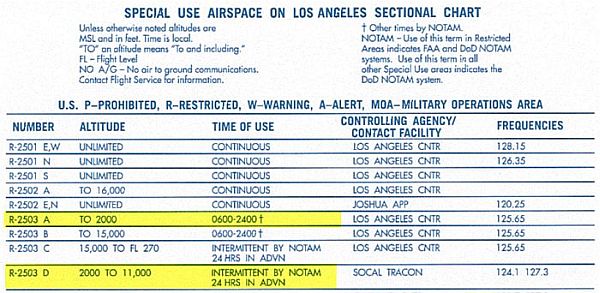eetrojan
Pattern Altitude
Hi all – I’m thinking about my first solo XC, a short two-leg flight from KSNA to KRNM and back. I may or may not choose this route, but one option is flying along the coast, say at 3500 feet, and passing next to restricted areas 2503A and 2503D. I could stay farther from shore and be clear of this airspace, but I prefer to remain closer if possible. Here’s a SkyVector chart:
http://goo.gl/AynYv
And, here’s the "in use" info from the legend on the Los Angeles sectional:

If I’m reading this right, the lower area 2503A is active from 0600-2400, but it's not a factor becaue it only extends to 2000 and I’ll be higher than that. However, the upper area 2503D extends from 2000 to 11,000, and is “intermittent by NOTAM 24 Hrs in advance.”
I would call SoCal (124.1) when I’m en route to confirm that 2503D is inactive, but I figured this would be a good time to understand the NOTAM issue. If it were going to be active, I'd rather know the night before.
What’s the best way to officially check the NOTAM status? Assuming I was going to fly in the morning (i.e. within 24 hours), would it be by requesting NOTAMS in an “outlook” report via duat.com with a route of KSNA VPLDP OCN KNRM? Or is there a better, more official way to check?
Thanks!
http://goo.gl/AynYv
And, here’s the "in use" info from the legend on the Los Angeles sectional:

If I’m reading this right, the lower area 2503A is active from 0600-2400, but it's not a factor becaue it only extends to 2000 and I’ll be higher than that. However, the upper area 2503D extends from 2000 to 11,000, and is “intermittent by NOTAM 24 Hrs in advance.”
I would call SoCal (124.1) when I’m en route to confirm that 2503D is inactive, but I figured this would be a good time to understand the NOTAM issue. If it were going to be active, I'd rather know the night before.
What’s the best way to officially check the NOTAM status? Assuming I was going to fly in the morning (i.e. within 24 hours), would it be by requesting NOTAMS in an “outlook” report via duat.com with a route of KSNA VPLDP OCN KNRM? Or is there a better, more official way to check?
Thanks!
Last edited:

